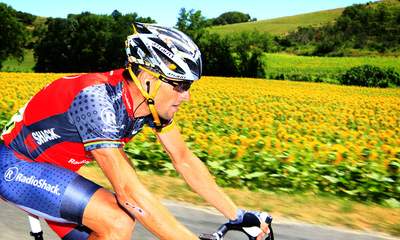'Armstrong Stored His Blood In A Fridge'

Grisly details from the report into the Lance Armstrong doping scandal have emerged - from hotel rooms turned into blood-transfusion centres to the way the cyclist's ex-wife handed out cortisone pills.
The report by the US Anti-Doping Agency (Usada) is more than 1,000 pages long and includes evidence from 11 of Armstrong's former teammates.
It describes how couriers would follow him around the tour to deliver drugs to him and his team, and how he would have his blood taken out and refrigerated, ready for a transfusion in the team doctor's hotel room on nights during the Tour de France.
The transfusions would boost oxygen levels in their blood, improving their stamina and recovery speed.
It also describes how thousands of dollars' worth of drugs were flushed down the toilet in the team campervan in a panic over a possible police raid during one Tour, and when in 1999 Armstrong had to wear makeup to cover a bruise on his arm caused by a syringe, before a public weigh-in.
Armstrong won the Tour six times as leader of the US Postal Service team from 1999-2004 and again in 2005 with the Discovery Channel as the primary sponsor.
But Usada said the path Armstrong chose to pursue "ran far outside the rules", describing it as "the most sophisticated, professionalised and successful doping programme that sport has ever seen".
Armstrong did not fight the charges, although he insists he never cheated.
Hours after the report was released the cyclist posted on Twitter : "What am I doing tonight? Hanging with my family, unaffected, and thinking about this. http://bit.ly/Po6mXT #onward."
The link was to a page on his website celebrating the work he has done for his cancer charity.
His attorney, Tim Herman, called the report "a one-sided hatchet job - a taxpayer funded tabloid piece rehashing old, disproved, unreliable allegations based largely on axe-grinders, serial perjurers, coerced testimony, sweetheart deals and threat-induced stories".
The report lays out the allegations in chronological order, starting in 1998 and running through to 2009.
It includes numerous examples of Armstrong using multiple drugs, including the blood-boosting hormone EPO, citing the "clear finding" of EPO in six blood samples from the 1999 Tour de France that were retested. UCI concluded those samples were mishandled and could not be used to prove anything.
It also describes how before the 1998 World Championships a drugs tester had arrived at the team's hotel. The report says that the team doctor smuggled a litre of saline under his raincoat and administered the solution to Armstrong, to bring his blood in line with normal levels of hematocrit, which can be raised after using certain performance enhancing drugs.
Cyclist Jonathan Vaughters remembered in his testimony how the doctor "had a good laugh about how he had been able to smuggle in saline and administer it to Lance essentially under the UCI inspector’s nose".
Testimony from Tyler Hamilton, Floyd Landis and George Hincapie also features, in which all three of his former teammates say they received EPO from Armstrong.
It also tells how a motorcyclist, known as Motoman, would follow the cyclists on the Tour and make deliveries of EPO for them to use during the race.
The report also describes how Landis had to "babysit" blood, which was being stored in a refrigerator hidden in a wardrobe in the master bedroom of Armstrong's apartment, whilst the cyclist went away on a training trip.
This involved checking the temperature of the blood every day.
Christian Vande Velde gives evidence of the pressure Armstrong put on the riders to go along with the doping programme.
He testified: "The conversation left me with no question that I was in the doghouse and that the only way forward with Armstrong's team was to get fully on Dr (Michele) Ferrari's doping programme."
The report also describes "an outstanding early warning system regarding drug tests".
One example came in 2000, when Hincapie found out there were drug testers at the hotel where Armstrong's team was staying.
Aware Armstrong had taken testosterone before the race, Hincapie alerted him and Armstrong dropped out of the race to avoid being tested, the report said.
Although she did not testify, Armstrong's ex-wife Kristin is mentioned 30 times in the report.
It is alleged he asked her to wrap banned cortisone pills in foil to hand out to his teammates.
"Kristin obliged Armstrong's request by wrapping the pills and handing them to the riders. One of the riders remarked, 'Lance's wife is rolling joints,'" the report says.
The report also depicts Armstrong's relationship with physician and training guru Michele Ferrari. Like Armstrong, Ferrari has received a lifetime ban from Usada.
Long thought of as the mastermind of Armstrong's alleged doping regime, Ferrari was investigated in Italy. Armstrong claimed he had cut ties with the doctor after a conviction in 2004 that was later overturned.
Usada cites financial records that show payments of at least \$210,000 made to Ferrari in the two years after that. It also cites emails from 2009 showing Armstrong asking Ferrari's son if he could make a \$25,000 cash payment the next time they met.
"The repeated efforts by Armstrong and his representatives to mischaracterize and minimize Armstrong's relationship with Ferrari are indicative of the true nature of that relationship," the report states. "If there is not something to hide, there is no need to hide it and certainly no need to repeatedly lie about it."
Armstrong revealed in August that he had given up the fight to clear his name, and was stripped of his seven Tour de France titles.

 Yahoo News
Yahoo News 